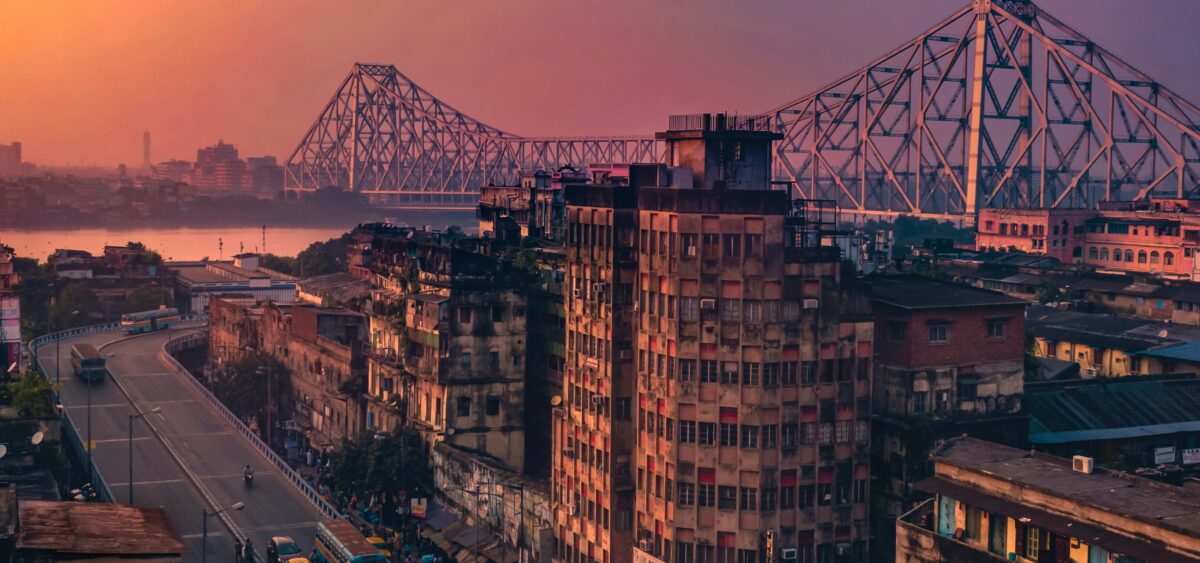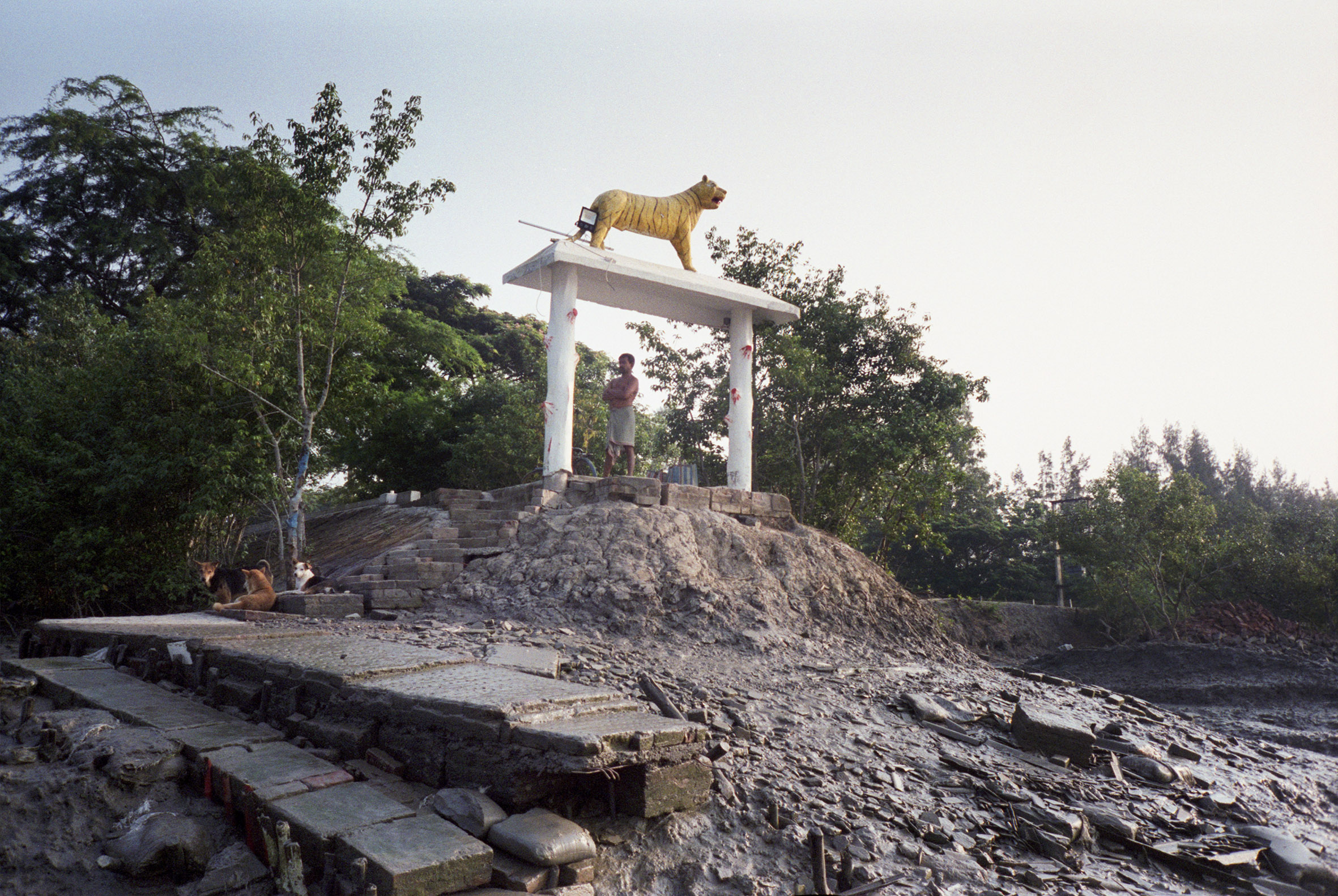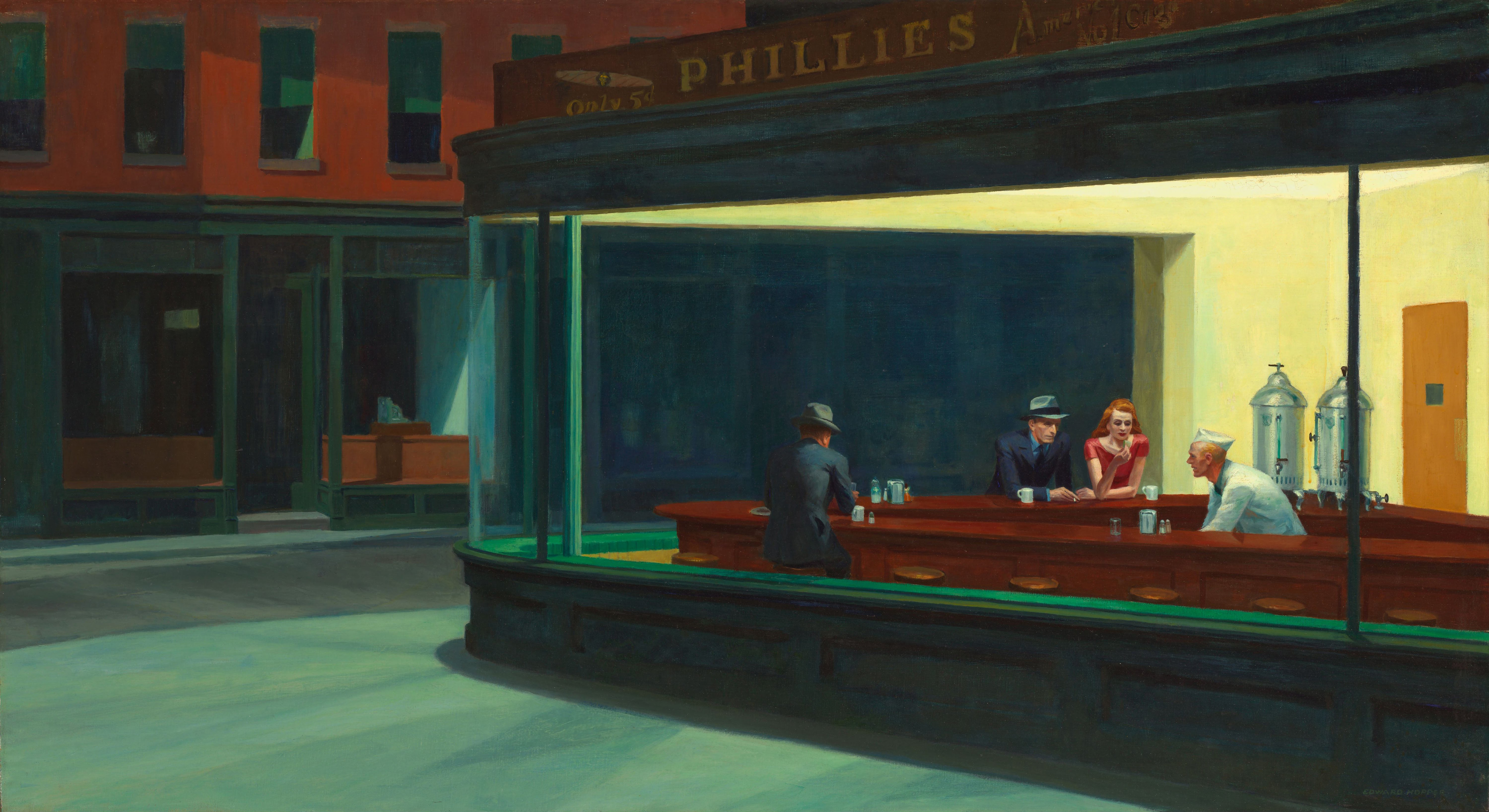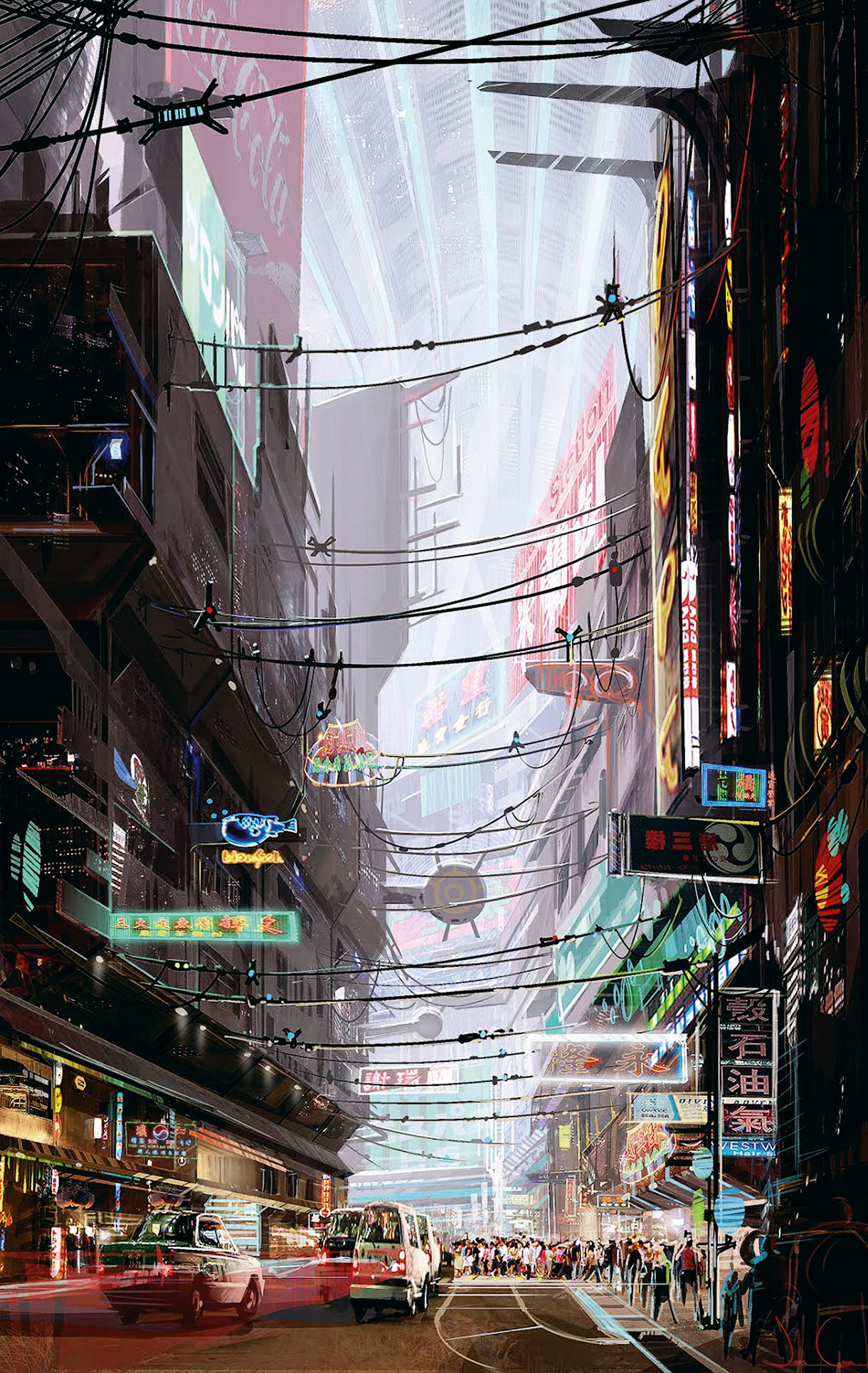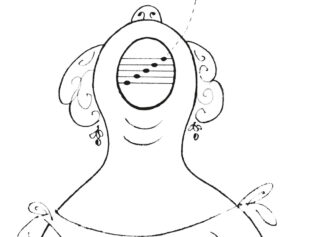
In Kolkata, time seems to spin around, allowing its citizens to avoid the future. Here, poems are still worth more than money and fig trees grow in old bedrooms. The city is slowly succumbing to nature and, one day, will be devoured by it.
“Isn’t this the perfect place to grow old?” Iftekhar ties his black hair in a high ponytail, his eyes glowing with excitement. I tug at the damp linen shirt stuck to my body and look around. We rushed in from the street through a chipped double door, passing the first small courtyard. Now we’re standing beneath the columns surrounding the second, spacious courtyard, currently deluged with streams of warm rain, the kind that falls suddenly and abundantly during the monsoon season. The downpour flows directly onto the marble fountain standing in the middle. It used to be the pride of this house, the centerpiece of the courtyard. Now it serves as a trash can for pots, wooden planks, and all kinds of junk. The city and its people don’t throw away the past. They prefer to hoard and persist. Welcome to the Kolkata time shelter.
“In all sections of the house you could arrange several rooms, each with a balcony. Imagine that! People could live like they did in their youth. Craftsmen, vendors, newspaper sellers would come by. And kids, from the red-light district and the nearby slums close to the river. Old age could be beautiful.” Iftekhar gives me a tour around his imagined nursing home for the elderly, designed to emulate the world of the past. In another city this would be impossible, but in Kolkata you can still tread the old paths. Here, everyday life changes slowly—one may even fail to notice the passing of time. In Hinduism, time is shaped as a wheel, not a straight line. It doesn’t fade away; it comes back and simply is.
Iftekhar’s dream is more than a fantasy. He wipes the screen of his smartphone on his jeans and shows me the business plan. Everything is planned out, split into phases, ready for realization. He needs an investor, as well as the consent of the one remaining owner, the last resident of the main part of the building. This lady lives here alone, almost cut off from the world. She doesn’t venture outside. Her servants bring everything to her. In Kolkata, it’s a typical kind of luxury: to have everything delivered, without the need to expose your body to the elements, dust and smog, noise and crowds. To persist—or perhaps be stuck—behind the arcades of a well-designed house, with a heavy wooden fan rotating overhead. To just be, instead of chasing “tomorrow,” “better,” or “more”. The future and progress do not impress Kolkata, nor its veteran inhabitants. The heir of the mansion, gray-haired and petite, in a worn-out but stylish cotton sari, appears in the window only to slam the shutters. She no longer has any expectations of this world. And what the world expects from her—or in this case, an ambitious forty-year-old with a plan to revitalize the building and make a group of elderly people happy—doesn’t have to happen immediately. Or ever.
All we can do is look at the slowly but surely dilapidating residence. The beautiful houses of Kolkata usually die with their aging residents; they grow weaker in tandem. They resemble living organisms that are subject to the same laws as their inhabitants—fatigue, illness, a longing for tenderness. As long as they go about their everyday lives, they somehow manage to hold on. I’ve seen a lot of dying houses in this city, including some that, one afternoon, fell to the ground where they had stood for decades or even hundreds of years, following a downpour, from old age, or from loneliness.
A Lady in Old Lace
Iftekhar and I are now looking at a house that still has a pulse and is still breathing. Its former splendor, however, hides beneath a sticky layer of decay. The courtyard around the fountain is lined with stone flooring in plant patterns. It’s surrounded by a one-story house, spread symmetrically on four sides of the world. In the windows on the first floor there are wooden blinds inspired by Sicilian architecture. Upstairs—enclosed, shared balconies with carved balustrades. In the past, these balconies served as the main artery of the house, a corridor connecting all the rooms. Family life flourished in the privacy of the top floors. Downstairs was reserved for servants, kitchens, and visitors, family ceremonies and religious rituals. From the balcony, people would look down on milk vendors or peddlers offering vegetables and various services. Keys, fresh flowers, or ironed laundry—anything that wasn’t worth a trip up and down the stone stairs (especially for a stout Indian matron)—would travel up and down in a bag attached to a piece of string. There are still millions of these bags in the city.
Today, these balconies are filled with boxes, pots and pans, and laundry. An assorted collection of clothes and miscellaneous objects suggests that the residence is inhabited by deprived people who are not related to one another. Despite all the junk, there’s still plenty of room—this was once a lavish residence housing a multi-generational family. It’s an example of the style of architecture favored by the wealthy Bengali aristocrats who, from the 17th century, made their fortune doing business with the British colonizers. They traded in jute, tea, and the most valuable currency—opium transported from Afghanistan and loaded here onto ships sailing to China.
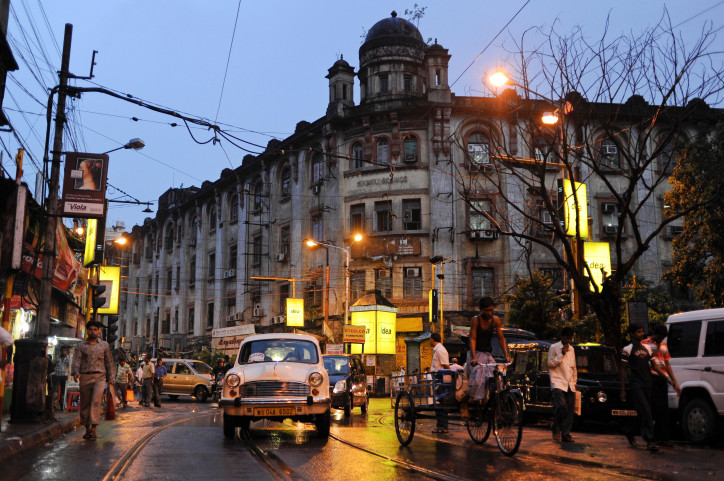
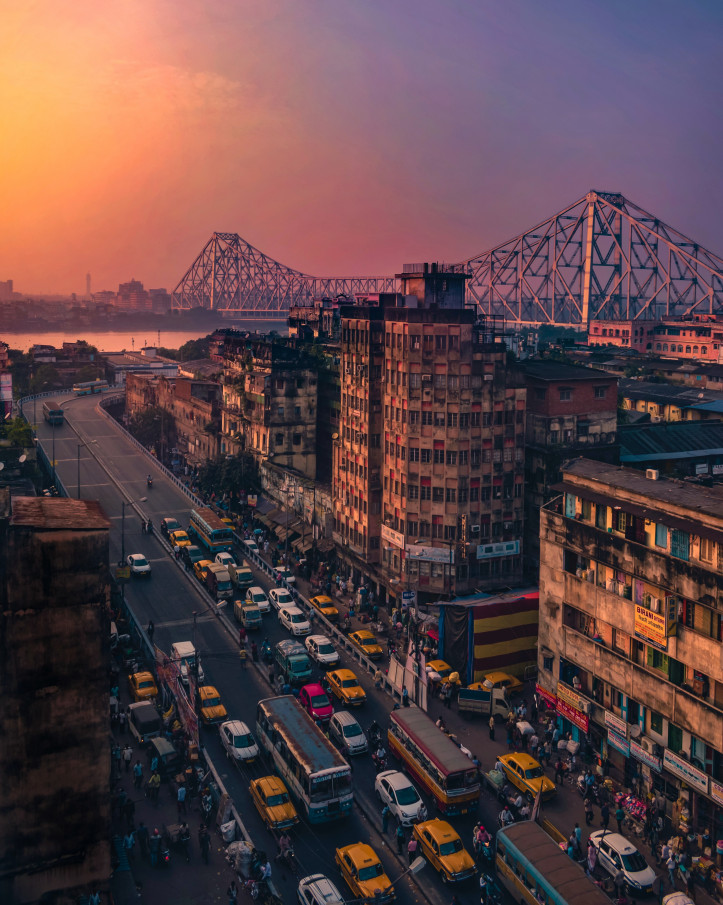
It was these aristocrats—the local elite—who built what is still known as northern Kolkata, the beating heart of the city. Today, there are also pacemakers and prostheses of urban ambitions, built in recent decades. But let’s not get ahead of ourselves—here, there’s no need to rush. Kolkata entered the stage late. It is the youngest of the largest Indian cities, although in comparison with the medieval Delhi or ancient Varanasi, Kolkata, a metropolis of the industrial age, resembles an old lady dressed in musty lace. The hostile climate and the whims of history have left their mark on the city. Until the 17th century, on the Hooghly River—a tributary of the Ganges, flowing close to where this gigantic river falls into the Bay of Bengal and the waters of the Indian Ocean—there were only fishing villages, malaria-ridden swamps, and marshes. British envoy Job Charnock (1630–1693) deemed the area an opportunity for the Empire. As the low banks of the river provided a safe haven for ships, the Bay of Bengal seemed to be a good starting point for travel from India to the “Far East.” Of the three villages that Charnock bought (one of which was called Kalikata, influencing the name that the metropolis would later acquire), the future capital of the most valuable royal colony—a tropical version of London—began to emerge. It took a little bribery and a few battles to legalize the city’s foundations. Since buildings had not yet been erected, Charnock’s first meetings with contractors took place in the shadow of an enormous banyan—an Indian fig tree—whose impressive three-hundred-year-old specimens still dot the city.
“White Town”
In the beginning, only a few British businessmen worked closely with the local Bengal majority. The first colonizers were interested in the local culture, languages, and beliefs. But the greater the prospects of fortune, the more people arrived in Kolkata tempted with visions of profit, and the more their appetite for segregation and domination grew. And so in the 18th century the so-called “White Town” (referring to the skin color of its colonial occupants) was born—the modern center of Kolkata surrounded by massive neoclassical buildings that were supposed to delight, intimidate, and leave absolutely no doubt as to who ruled India. The mammoth structures of the General Post Office, the High Court, and the Victoria Memorial were surrounded by vast avenues separated by spacious parks and squares. At what was then known as Dalhousie Square there stood the impressive building of the Dead Letter Office, housing mail whose addressees had died before it was received. And there were plenty of them, because the humid climate of Kolkata caused a lot of diseases, mercilessly decimating royal traders and accountants. The gravestones on the tombs at the Christian cemetery on Park Street serve as a reminder that it was difficult to live to the age of thirty. At New Year’s receptions held at the Town Hall, attendees sincerely congratulated each other for every year spent. As for the missed letters, they laid there until the building was transformed into a telegraph office, and the unread expressions of love, longing, and financial settlements wasted away. Kolkata seems unable to care about its own history or honor its heritage. It is devoured by mold and damp—and is okay with it. This could be seen as inertia, a disease eating away at its urban soul. Or one could see humility in it. Who says that cities must triumph, shine with promises of a better tomorrow? They can also succumb and show maturity, coming to terms with their own passing.
In the British “White Town,” there was also a defensive fortress (although Kolkata could not really be attacked due to its swampy surroundings), a horse racing track, and the vast Maidan (the Brigade Parade Ground), perfect for organizing military displays of power. It was also—which the British did not foresee—great for carrying out mass protests and strikes, leading to the final departure of Lord Mountbatten, the last viceroy of India, by ship from Mumbai in 1947. Until then, for two centuries, native Bengalis entered the most impressive buildings of Kolkata as servants. People would take their coffee in Italian cafés, rest, and dance in luxury hotels; horse carriages would roll through the streets. It is hard to imagine this splendor today, when the city’s arteries are strewn with thousands of stalls and shops, in which the poor forge their modest existence. Meanwhile, a medley of ancient buses, beaten cars, bicycles, tuk-tuks, and barefoot rickshaw-wallahs pulling carts with passengers move along the roads in a hiccup-like rhythm. Recently, they were joined by Uber drivers in beaten white Toyotas and the nouveau-riche in 4×4s and SUVs. Together, they all drift through the belly of a metropolis that houses seventeen million people—the provincial, worn out beauty of independent India.
In the process of “White Town”’s construction, the indigenous population was displaced to the north. There emerged the so-called “Black Town” (again, a reference to skin color)—the old Kolkata. Here, the network of streets is much denser and multiplicity and diversity are the norm. Followers of numerous religions live in neighboring streets or even next door to one another. The last remaining active synagogue is looked after by Muslims, since the handful of elderly Jews are too weak to do so. A fire is burning in the Zoroastrian temple; there are just 234 of them left in the entire city. But why didn’t a thin trickle of faith turn into a lively stream? This was the case with Buddhism in India, which was revived in Kolkata. Chinese, Jain, and Sikh temples are doing just fine. Although they are in the minority compared with the all-pervasive Hindu temples and Muslim mosques, all denominations can feel at home here. History forced Kolkata to learn acceptance and hospitality. After all, doing business with the British attracted masses of traders, craftsmen, and servants of all religions. In turn, the colonial policy pushed them into their designated place in the hierarchy, all equal in subservience to the colonial rule, unified by the same fate.
“Black Town”
The Bengalis had their own elites, noble families, and powerful Nawabs (viceroys) long before the Europeans arrived, but colonial rule created a new group: the babus, 19th-century-Kolkata’s nouveau-riche. Some of them liked to show off at all costs. They rode in zebra-drawn carriages, had their residences rinsed with rose water each morning, and even organized ostentatiously expensive wedding ceremonies for their dogs. But there were also others, associated with the refined culture of Bengal, a region that not only remained the granary of India, but also a mecca of the intelligentsia and artists. It was the babus who donated their fortunes toward the development of art and education. Architects brought in from the Middle East and Europe designed beautiful mansions complete with courtyards, guest houses for artists, stages, and theaters. The audience were their neighbors, in front of whom the babus would show off their patronage of first-class dancers, instrumentalists, and poets. Art and artistic ambitions emanated widely from these open-air salons (performances took place in courtyards). Thanks to this, Kolkata’s craftsmen, cleaners, and shopkeepers can recite poetry and sing, even today. Wealthy aristocrats donated land to universities and colleges, funded hospitals, markets, and riverside ghats—the series of stone steps where clothes are washed, that serve as communication hubs for boats and ferries, and where temples for cleansing rituals and prayers are located.
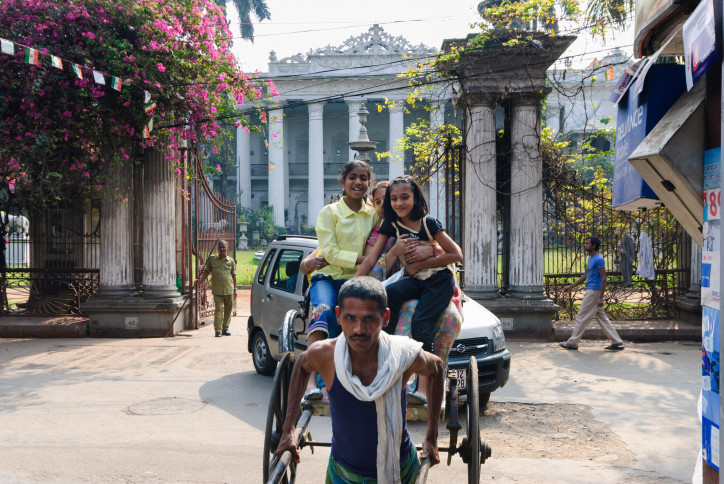
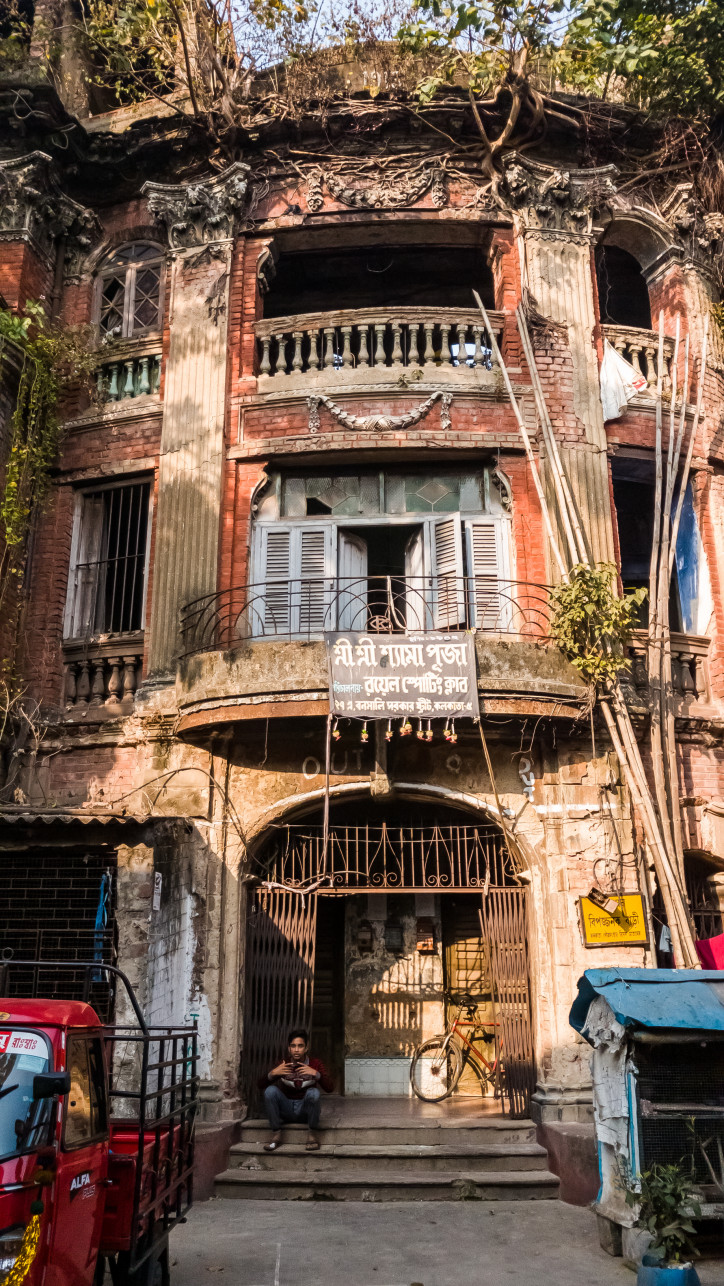
Wealthy families, such as the Mullicks and the Tagores, left their own mark on the vision, passions, and ambitions of the city. The blend of Western influences and the local elite turned Kolkata into a metropolis that brought modernity to south Asia. It was the first town in the region to have a telephone network and elevator. Here, entire districts were electrified early on and residents learned to ride the first trams. Kolkata was also the home of the subcontinent’s first printing press (to this day, hand-operated presses from two hundred years ago are still used in the university district), first secular university, and first computer. There was a time when the world associated Kolkata with breakthroughs, newness, and invention. This is hard to believe today while sipping morning tea at the ghats, just a few minutes’ walk from where Job Charnock’s banyan tree once grew and where the train station is now thriving.
At the stone stairs, among the morning noise, a dozen men are bathing and praying. There are boats coming in with small loads and fish. This place—a combination of kitchen and temple—is home to one of the best cups of tea in the city. Thick, sweet, and perfectly spiced, it burns the lips, revives, and empowers. It’s prepared by a roughly fifty-year-old woman—somehow, she manages to pour the boiling beverage while talking on her cellphone. A boy, perhaps her son, briskly decorates statues and paintings of the goddess Kali. He pulls out fresh garlands of jasmine and red hibiscus from a bag, hangs them up, and begins to light incense. The day must begin with praising the gods, as no business can do well without their favor. Hence the incense, the folding of hands, the whispered prayer. Meanwhile, a large pot is steaming on the stove. Soon, drivers from the trucks parked nearby will finish bathing and come in—wearing sleeveless tank tops, creased pants, and rubber flip-flops—for a plate of potato curry and flatbread. You can already hear them clearing their throats, spitting, and shuffling their feet.
Just behind the line of parked vehicles, there’s a tangle of narrow alleyways tightly built up with old houses, three-hundred-year-old mansions, and smaller, slightly newer buildings that make up a living archive of the past. The architecture of a long-gone era, modernized just a little—an extension here, a terrace, balcony, or new roof there—is now dense and serves various functions. It’s hard to tell where a workshop ends and a restaurant begins, or whether this extra room is just the kitchen or the entire house of a large family. Subsequent layers of life overlap and coexist, instead of pushing each other out. While many cities around the world are attempting to reinvent themselves, the old Kolkata remains old. It simultaneously exists across several centuries, absorbing successive epochs along with their ideological fluxes, inventions, and beliefs. There is wisdom in this, consisting not in momentum towards modernity, but in the accumulation of knowledge, material, and ideology that occurs organically, in a decentralized manner. Most houses, buildings, factories, and warehouses in the northern part of the city are nobody’s land—although they are densely inhabited and intensely used, they are to some extent isolated, since no one takes responsibility for their condition and future. This is possible, because the winds of history brought Kolkata great misfortunes and great dreams that in turn slowed, but also nourished, one another.
Time, not Money
Under British rule, the city grew and flourished until 1912, when the occupiers moved the capital to the centrally-located Delhi. With that, the spirit of the future, as well as money, began to leave Kolkata. The agricultural province of Bengal maintained the unfair land tenure system imposed by the British. Poor peasants forced to work the land began falling into debt. As World War II erupted, the obligation to produce more and more in order to support the British military, coupled with rapidly rising food prices, led to a famine that—long ignored by the colonizers—killed nearly four million citizens. At that point, the first wave of desperate people, struggling to survive, arrived in Kolkata.
Another, even larger group arrived after 1947, when the British left the subcontinent, dividing it into Hindu India and Muslim Pakistan. The partition stoked religious hatred, leading to bloody massacres. Millions of refugees arrived in Kolkata. The city choked under their weight, the streets filling with homeless people condemned to beg or starve. Kolkata became the world capital of poverty. Today, somewhat similarly, the failing infrastructure and lack of space and work has given rise to slums, or, to put it mildly, informal districts where an increasing percentage of the world’s urban population will live in the coming decades.
In the 1970s, the third wave of migrants—starving refugees from Bangladesh—turned the southern villages of Kolkata into suburbs. These were eventually surrounded by a beltway and absorbed into the city. Newly-planned districts—such as Bidhannagar—were to provide a response to the overcrowding. But to imagine a better life, touching the sky in lofty skyscrapers, one must negotiate with nature. Kolkata is dangerously expanding closer and closer to the Ganges Delta. To enable this, marshes—which provide the most important natural barrier against flooding, cyclones, and rising water levels—are being drained. The more Kolkata moves toward the future, the more it tightens its own noose. The city is a victim of late capitalism—its “expand and die” phase.
In the oldest districts of Kolkata, money works quite differently than in the middle-class housing estates. Here, it still means less than poetry, a quick prayer, a moment spent together under a tree, a chat over tea. Time doesn’t only equal money.
Not everything has a price tag. Water is free. In drying-up India, where conflicts over water are already commonplace, free access to this common good seems to be a genuine phenomenon. Subsequent groups of refugees, agricultural workers, and economic migrants move into residences abandoned by the former aristocracy. What right do they have to live in them? It’s simple—the law of urgent need, in the face of a state that cannot provide prosperity to India’s large population. Also—the law of history. After all, Kolkata was ruled by elected Marxists for thirty-five years, starting in the 1970s. Ever since, anyone who occupies a residence or house for five years becomes its lawful resident. People rarely bother to legalize their stay and there are few owners keen to face the bureaucratic machine, blown up to monstrous proportions by the Marxists.
The years of left-wing local governments brought on an era of great stagnation. While industries and skyscrapers flourished in other parts of Asia, Kolkata pushed away investors with strikes and organized trade unions. For thirty-five years, the practical implementation of ideology promoting the working class continued. The free-market reforms that captured India in the early 1990s arrived in Kolkata two decades later, and never really caught on. There are no international corporations or brands here, nor is there a pursuit of profit or a work environment conducive to forging a career. Whoever dreams of this leaves; only the romantics stay behind.
Stormy Weather
Those romantics include Anjali, who is currently eating tamarind-flavored sorbet with me. We’re sitting at Paramount, the legendary beverage shop just a stone’s throw from the College Street bookstore district. Waiters wander around distributing glasses filled with crushed ice and sweet fruit syrups. Anyone who meant anything throughout the history of Kolkata also sat here and slurped, just like we are now. Writers, poets, revolutionaries, scholars, film directors—all the local intelligentsia, the unique creation of a city persistently feeding on ideas. But Anjali is twenty-four-years-old and feels she might soon be forced to give in. Unlike the friends with whom she graduated from the Journalism Department, she didn’t move to Mumbai, Delhi, or somewhere where life moves faster and the job ladder might lead to the top.
Since Anjali loves Kolkata and doesn’t intend to leave, she became a guide. I go out with her and get to know new parts of the city I’ve been visiting and discovering, bit by bit, over the past twenty years. Anjali is yet another young person who tells me that Kolkata is opening a new chapter, but not the kind they’d dream of. “This city, saturated with the atmosphere of academia and poetry, has begun to turn back into a village. For the first time in several centuries, young people no longer dream of education and a better quality of life. They don’t even dream of happiness. They just want to make money, fast,” says Anjali. Her friend Koyel, a traveler and Instagrammer, adds: “Those with ambition move to more developed cities. Kolkata is where people from rural areas come to. While my friends are getting on planes, trains from the villages arrive in Kolkata every day.”
As if to confirm this, Anjali and Koyel take me to Sealdah Railway Station, a symbol of commuting hell, mayhem, and chaos. On the platforms is a sea of people, an inexhaustible crowd, constant movement. “Around a million people arrive here every day,” Anjali says. “As you can see, it’s not to work desk jobs.”
And I can definitely see that. Cheap, artificial fabric clothes, skin darkened from hours spent in the sun, swollen veins and bundles on their heads, legs and hands roughed by physical labor. These are the people who the new populist authorities of Kolkata have been addressing for almost a decade. It is for them that local politicians “beautify” the city—by restoring the exteriors of monuments for the amusement of newcomers from the provinces. They also make it easier for them to move here, simplifying the process of getting basic work. The intellectual elites of the city are in retreat and feel condemned to a political alliance with rural parties serving populism for the poorest, since their only alternative is the fascist right-wing. Professors and filmmakers are choosing the lesser evil—a government of the people instead of a government of hatred. They’re trying to survive, too.
Those who, like Iftekhar and Anjali, want to preserve the legacy of Kolkata—its architecture, customs, and legends—are left to their own devices. They’ve picked the role of guardians of memories. Both admit that in a world where the overwhelming majority worry about everyday survival, nurturing memories is a luxury. Today, the city belongs to them.
What will become of Kolkata in the future? Perhaps it will turn into a cluster of villages full of local character, close ties, and small businesses. Or perhaps it will be one giant village enjoying the luxury of quick commuting and concentrated businesses. Maybe it will fall apart, deprived of a center and elites capable of setting the course for progress. Perhaps it will become demoralized, or the opposite: it will turn to tradition and beliefs, and will carry on in fragmented diversity and conservative morality.
These questions contain the essence of today’s Kolkata. The city shares the very unattractive future of many expanding cities around the world. This is the reality of mass migration to urban areas in Asia, Africa, and South America—and it is devoid of any ideals. Millions are arriving in metropolitan areas that are not prepared for this and thus cannot offer these new residents what they want. Migrants show up and often use cities in an ad hoc, unceremonious way. They forge their own paths, create makeshift neighborhoods, and build new layers of life, without asking anyone for advice, without looking back. Nothing can stop this trend, even though it is catastrophic in global terms. Cities produce the most greenhouse gasses and are the main drivers of climate change. Hiding in a metropolis is like running towards a tornado.
Perhaps nature will bring the final answer to these questions. If some great disaster doesn’t condemn the inhabitants of Kolkata to exile first, nature will slowly claim back the areas that were ripped from her. People settled here at the cost of drying out the land. Now the greatest threat to everything they’ve created is water. The ocean is getting bolder and increasingly invading the land around the Bay of Bengal, annihilating crops. Monsoons and floods are damaging buildings and washing away roads and flyovers. With each rainy season, more buildings collapse. Two years ago, a strong cyclone ripped through Kolkata’s alleys, blowing away rooftops and throwing people around like puppets. But fig trees work quietly—they grow between the bricks of old houses and slowly entwine the entire structure. Their branches spread out onto balconies, their roots climb through windows and into the rooms. This is how nature absorbs culture. The future may be a return to the natural order. It certainly wouldn’t be the first fairy tale about a kingdom devoured by a persevering jungle.
For the time being, Iftekhar has managed to preserve one old building. In it, he created a small hotel. He also has ideas for saving other ruins: he wants to transform them into a cultural center, a library, a recreation center. Recently, he’s not been completely alone in this perverse love. Someone else in the neighborhood has just started a major renovation of a two-hundred-year-old tenement house. Together, they are two swallows flying against the wind.


